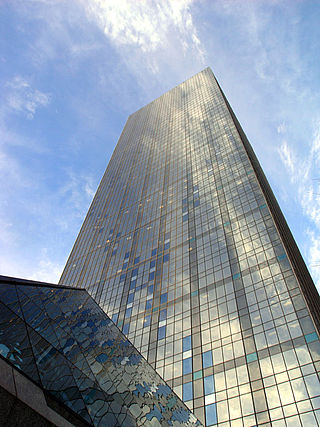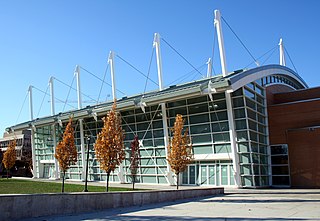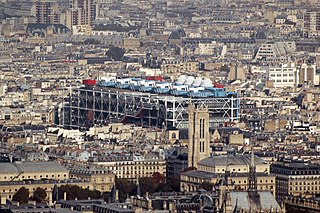The architectural technologist, also known as a building technologist, provides technical building design services and is trained in architectural technology, building technical design and construction.
Architectural technologists apply the science of architecture and typically concentrate on the technology of building, design technology and construction. The training of an architectural technologist concentrates on the ever-increasingly complex technical aspects in a building project, but matters of aesthetics, space, light and circulation are also involved within the technical design, leading the professional to assume decisions which are also non-technical. [1] They can or may negotiate the construction project, and manage the process from conception through to completion, typically focusing on the technical aspects of a building project.
Most architectural technologists [2] are employed in architectural and engineering firms, or with municipal authorities; but many provide independent professional services directly to clients, [3] although restricted by law in some countries. Others work in product development or sales with manufacturers.
In Britain, Ireland, Sweden, Denmark, Hong-Kong (Chartered Architectural Technologist), Canada (Architectural Technologist or Registered Building Technologist), Argentina (M.M.O Maestro Mayor de Obras / Chartered Architecture & Building Science Technologist) and other nations, they have many abilities which are extremely useful in a technological sense to work alongside architects, engineers and other professionals - the training of a technologist provides skills in building and architectural technology. It is an important role in the current building climate. Architectural technologists may be directors or shareholders of an architectural firm (where permitted by the jurisdiction and legal structure). To become an Architectural Technologist, a four-year degree (or equivalent) in Architectural Technology (in Canada normally a three year diploma) is required, which can be followed by a Master's Degree, with structured professional and occupational experience.
Most provinces in Canada have an association representing Architectural Technologists and Technicians.
In the province of Ontario, the Association of Architectural Technologists of Ontario (AATO) was founded in 1969. The Association holds four titles, Architectural Technologist, Registered Building Technologist, Architectural Technician and Registered Building Technician and the French equivalent of each title. The Association recognizes students and has an Internship process for members that incorporates both education and work experience for members. Our membership is involved in all aspects of the construction industry and often form part of the team of professionals on all types of projects.
In the Republic of Ireland, the Royal Institute of the Architects of Ireland RIAI declares being the leading professional body for Architectural Technologists in Ireland. The RIAI recognises the professional Architectural Technologist as a technical designer, skilled in the application and integration of construction technologies in the building design process. RIAI Architectural Technologists are recognised as professional partners to Architects in the delivery of exemplary buildings in the Republic of Ireland and worldwide. [4] However, the Royal Institute of the Architects of Ireland has always prevented its technician members to provide a full architectural service. Many qualified architectural technologists believe that a conflict of interest exists, that the RIAI represents architects and cannot adequately defend the interests of architectural technologists: "The RIAI acts as the Registration Body and Competent Authority for "Architects" in Ireland and only provides support services for Irish AT'". [5]
Another representative body is the Chartered Institute of Architectural Technologists (CIAT). The technologist membership of the RIAI (RIAI tech) is equivalent to the associate membership of CIAT (ACIAT). Chartered members of CIAT (MCIAT) are qualified and recognised to lead a project from inception through to completion. The RIAI and the CIAT were represented within the Building Regulations Advisory Body (BRAB) which advised the Minister for the Environment on matters relating to the Building Regulations. BRAB is no longer active. [6] CIAT is now challenging the Building Control Regulations 2014, which are depriving its members from providing full architectural services in the Republic of Ireland. [7] The Irish Government appears to have no valid reason to prevent CIAT members from practising in the Republic of Ireland. The restrictions imposed on members of the CIAT are viewed as anti-competitive and in breach of European Law for free movement of services. [8] The CIAT is awaiting for an opinion from the European Commission on this issue. [9]
In South Africa the profession is by the South African Institute of Architectural Technologists SAIAT. [10] Senior architectural technologists (10 years or more in practice) enjoy the same statute than architects. The South African Institute of Architects (SAIA) explains that: "Architecture can be practiced in one of four categories of registered person, namely professional architect, professional senior architectural technologist, professional technologist or professional draughtsperson. The possibility of progression from one category to the next has been provided for in the Regulations." [11]
In the United Kingdom, chartered architectural technologists enjoy the same status as architects. They deliver similar services with a different orientation. The Chartered Institute of Architectural Technologists CIAT regulates the profession. CIAT defines chartered architectural technologists as follow: Chartered Architectural Technologists provide architectural design services and solutions. They are specialists in the science of architecture, building design and construction and form the link between concept and construction. They negotiate the construction project and manage the process from conception through to completion. Chartered Architectural Technologists, MCIAT, may practise on their own account or with fellow Chartered Architectural Technologists, architects, engineers, surveyors and other professionals within the construction industry. As professionals adhering to a Code of Conduct, they are required to obtain and maintain mandatory Professional Indemnity Insurance (PII) if providing services directly to clients. [12] They specify products with reference to the RIBA Product Selector , Architects Standard Catalogue, Barbour Index [13] and trade literature.

An architect is a person who plans, designs, and oversees the construction of buildings. To practice architecture means to provide services in connection with the design of buildings and the space within the site surrounding the buildings that have human occupancy or use as their principal purpose. Etymologically, the term architect derives from the Latinarchitectus, which derives from the Greek, i.e., chief builder.

An engineering technologist is a professional trained in certain aspects of development and implementation of a respective area of technology. An education in engineering technology concentrates more on application and less on theory than does an engineering education. Engineering technologists often assist engineers; but after years of experience, they can also become engineers. Like engineers, areas where engineering technologists can work include product design, fabrication, and testing. Engineering technologists sometimes rise to senior management positions in industry or become entrepreneurs.

The Institution of Engineers of Ireland or the IEI, is the second oldest Engineering Society on the islands of Great Britain and Ireland, and was established in 1835. The institution primarily represents members based in Ireland.
Building design, also called architectural design, refers to the broadly based architectural, engineering and technical applications to the design of buildings. All building projects require the services of a building designer, typically a licensed architect. Smaller, less complicated projects often do not require a licensed professional, and the design of such projects is often undertaken by building designers, draftspersons, interior designers, or contractors. Larger, more complex building projects require the services of many professionals trained in specialist disciplines, usually coordinated by an architect.

The Royal Institute of the Architects of Ireland (RIAI) founded in 1839, is the "competent authority for architects and professional body for Architecture in the Republic of Ireland."

The Institute of Marine Engineering, Science and Technology (IMarEST) is the international membership body and learned society for marine professionals operating in the spheres of marine engineering, science, or technology. It has registered charity status in the UK. It has a worldwide membership of over 12,000 individuals based in over 128 countries. The Institute is a member of the UK Science Council and a licensed body of the Engineering Council UK.

Engineering education is the activity of teaching knowledge and principles to the professional practice of engineering. It includes an initial education, and any advanced education and specializations that follow. Engineering education is typically accompanied by additional postgraduate examinations and supervised training as the requirements for a professional engineering license. The length of education, and training to qualify as a basic professional engineer, is typically five years, with 15–20 years for an engineer who takes responsibility for major projects.

Construction Industry Council (CIC) is the representative forum for professional bodies, research organisations and specialist business associations in the United Kingdom construction industry.

A building engineer is recognised as being expert in the use of technology for the design, construction, assessment and maintenance of the built environment. Commercial Building Engineers are concerned with the planning, design, construction, operation, renovation, and maintenance of buildings, as well as with their impacts on the surrounding environment.

Architectural Engineer (PE) is a professional engineering designation in the United States. The architectural engineer applies the knowledge and skills of broader engineering disciplines to the design, construction, operation, maintenance, and renovation of buildings and their component systems while paying careful attention to their effects on the surrounding environment.

A drafter is an engineering technician who makes detailed technical drawings or plans for machinery, buildings, electronics, infrastructure, sections, etc. Drafters use computer software and manual sketches to convert the designs, plans, and layouts of engineers and architects into a set of technical drawings. Drafters operate as the supporting developers and sketch engineering designs and drawings from preliminary design concepts.

Architectural engineering or architecture engineering, also known as building engineering, is a discipline that deals with the engineering and construction of buildings, such as environmental, structural, mechanical, electrical, computational, embeddable, and other research domains. It is related to Architecture, Mechatronics Engineering, Computer Engineering, Aerospace Engineering, and Civil Engineering, but distinguished from Interior Design and Architectural Design as an art and science of designing infrastructure through these various engineering disciplines, from which properly align with many related surrounding engineering advancements.

The Australian Institute of Building (AIB) is a professional society founded in 1951, incorporated in 1955 and granted a royal charter in 1969. The institute is an association of building professionals, associate professionals and technicians engaged in building practice, teaching, or research throughout Australia and overseas. It has chapter offices in Hong Kong and Singapore and had a chapter office in New Zealand until the formation of the New Zealand Institute of Building in 1984.
A chartered professional is a person who has gained a specific level of skill or competence in a particular field of work, which has been recognised by the award of a formal credential by a relevant professional organization. Chartered status is considered a mark of professional competency, and is awarded mainly by chartered professional bodies and learned societies. Common in Britain, it is also used in Ireland, the United States and the Commonwealth, and has been adopted by organizations around the world.
The Chartered Institute of Architectural Technologists (CIAT) is the qualifying body for architectural technology, primarily in the United Kingdom but also internationally. The institute has members in overseas centres such as Hong Kong and the Republic of Ireland. 'Chartered Architectural Technologist' is a protected title listed in the European Directive 2005/36/EC. Chartered Members of the Institute may use the designation MCIAT and the title of Chartered Architectural Technologist. CIAT is a member of AEEBC (Association d'Experts Européennes du Bâtiment et de la Construction).
Professional requirements for architects vary from place to place, but usually consist of three elements: a university degree or advanced education, a period of internship or training in an office, and examination for registration with a jurisdiction.
The Architects' Alliance of Ireland (AAoI) (Irish: Ailtirí 'Comhaontas na hÉireann) is an Irish pressure group founded in 2009. Its purpose is to lobby for a change in recent legislation in Ireland.

Architectural technology, or building technology, is the application of technology to the design of buildings. It is a component of architecture and building engineering and is sometimes viewed as a distinct discipline or sub-category. New materials and technologies generated new design challenges and construction methods throughout the evolution of building, especially since the advent of industrialisation in the 19th century. Architectural technology is related to the different elements of a building and their interactions; it is closely aligned with advances in building science.
This section may be in need of reorganization to comply with Wikipedia's layout guidelines .(July 2023) |